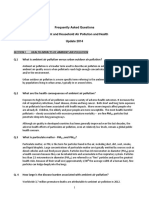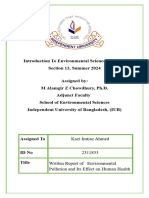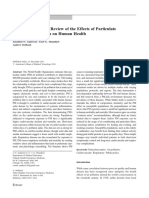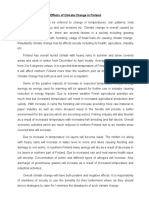0 ratings0% found this document useful (0 votes)
51 viewsHealth Effects: Common Disease Associated With Air Pollution and How Pervention
Health Effects: Common Disease Associated With Air Pollution and How Pervention
Uploaded by
Yasin HusseinAir pollution is caused by both natural and human sources and can harm human health, other living organisms, and the environment. It is a major risk factor for diseases like respiratory infections, heart disease, COPD, and lung cancer. Outdoor air pollution causes millions of premature deaths worldwide each year. Reducing fossil fuel use and implementing land use planning and pollution control technologies can help reduce air pollution.
Copyright:
© All Rights Reserved
Available Formats
Download as DOC, PDF, TXT or read online from Scribd
Health Effects: Common Disease Associated With Air Pollution and How Pervention
Health Effects: Common Disease Associated With Air Pollution and How Pervention
Uploaded by
Yasin Hussein0 ratings0% found this document useful (0 votes)
51 views3 pagesAir pollution is caused by both natural and human sources and can harm human health, other living organisms, and the environment. It is a major risk factor for diseases like respiratory infections, heart disease, COPD, and lung cancer. Outdoor air pollution causes millions of premature deaths worldwide each year. Reducing fossil fuel use and implementing land use planning and pollution control technologies can help reduce air pollution.
Original Title
Air Pollution
Copyright
© © All Rights Reserved
Available Formats
DOC, PDF, TXT or read online from Scribd
Share this document
Did you find this document useful?
Is this content inappropriate?
Air pollution is caused by both natural and human sources and can harm human health, other living organisms, and the environment. It is a major risk factor for diseases like respiratory infections, heart disease, COPD, and lung cancer. Outdoor air pollution causes millions of premature deaths worldwide each year. Reducing fossil fuel use and implementing land use planning and pollution control technologies can help reduce air pollution.
Copyright:
© All Rights Reserved
Available Formats
Download as DOC, PDF, TXT or read online from Scribd
Download as doc, pdf, or txt
0 ratings0% found this document useful (0 votes)
51 views3 pagesHealth Effects: Common Disease Associated With Air Pollution and How Pervention
Health Effects: Common Disease Associated With Air Pollution and How Pervention
Uploaded by
Yasin HusseinAir pollution is caused by both natural and human sources and can harm human health, other living organisms, and the environment. It is a major risk factor for diseases like respiratory infections, heart disease, COPD, and lung cancer. Outdoor air pollution causes millions of premature deaths worldwide each year. Reducing fossil fuel use and implementing land use planning and pollution control technologies can help reduce air pollution.
Copyright:
© All Rights Reserved
Available Formats
Download as DOC, PDF, TXT or read online from Scribd
Download as doc, pdf, or txt
You are on page 1of 3
Common disease associated with air pollution and how pervention
Air pollution is the presence of substances in the atmosphere that are
harmful to the health of humans and other living beings, or cause damage
to the climate or to materials.
There are many different types of air pollutants, such as gases (such as
ammonia, carbon monoxide, sulfur dioxide, nitrous oxides, methane and
chlorofluorocarbons), particulates (both organic and inorganic), and
biological molecules.
Air pollution may cause diseases, allergies and even death to humans; it
may also cause harm to other living organisms such as animals and food
crops, and may damage the natural environment (for example, climate
change, ozone depletion or habitat degradation) or built environment (for
example, acid rain). Both human activity and natural processes can
generate air pollution.
Air pollution is a significant risk factor for a number of pollution-related
diseases, including respiratory infections, heart disease, COPD, stroke
and lung cancer.[1] The human health effects of poor air quality are far
reaching, but principally affect the body's respiratory system and the
cardiovascular system. Individual reactions to air pollutants depend on
the type of pollutant a person is exposed to, the degree of exposure, and
the individual's health status and genetics.[2] Indoor air pollution and
poor urban air quality are listed as two of the world's worst toxic
pollution problems in the 2008 Blacksmith Institute World's Worst
Polluted Places report.[3] Outdoor air pollution alone causes 2.1[4][5] to
4.21 million deaths annually.[1][6] Overall, air pollution causes the
deaths of around 7 million people worldwide each year, and is the world's
largest single environmental health risk.[1][7][8] The scope of the air
pollution crisis is enormous: 90% of the world's population breathes dirty
air to some degree. Although the health consequences are extensive, the
way the problem is handled is often haphazard.
Health effects
Even at levels lower than those considered safe by United States
regulators, exposure to three components of air pollution, fine particulate
matter, nitrogen dioxide and ozone, correlates with cardiac and
respiratory illness.[49] In 2012, air pollution caused premature deaths on
average of 1 year in Europe, and was a significant risk factor for a
number of pollution-related diseases, including respiratory infections,
heart disease, COPD, stroke and lung cancer.[1] The health effects caused
by air pollution may include difficulty in breathing, wheezing, coughing,
asthma[50] and worsening of existing respiratory and cardiac conditions.
These effects can result in increased medication use, increased doctor or
emergency department visits, more hospital admissions and premature
death. The human health effects of poor air quality are far reaching, but
principally affect the body's respiratory system and the cardiovascular
system. Individual reactions to air pollutants depend on the type of
pollutant a person is exposed to, the degree of exposure, and the
individual's health status and genetics.[2] The most common sources of
air pollution include particulates, ozone, nitrogen dioxide, and sulfur
dioxide. Children aged less than five years that live in developing
countries are the most vulnerable population in terms of total deaths
attributable to indoor and outdoor air pollution.[51]
Mortality
The World Health Organization estimated in 2014 that every year air
pollution causes the premature death of some 7 million people
worldwide.[1] Studies published in March 2019 indicated that the number
may be around 8.8 million.[53]
Cardiovascular disease
A 2007 review of evidence found that, ambient air pollution exposure is a
risk factor correlating with increased total mortality from cardiovascular
events (range: 12% to 14% per 10 µg/m3 increase).[74][clarification
needed]
Air pollution is also emerging as a risk factor for stroke, particularly in
developing countries where pollutant levels are highest.[75] A 2007 study
found that in women, air pollution is not associated with hemorrhagic but
with ischemic stroke.[76] Air pollution was also found to be associated
with increased incidence and mortality from coronary stroke in a cohort
study in 2011.[77] Associations are believed to be causal and effects may
be mediated by vasoconstriction, low-grade inflammation and
atherosclerosis[78] Other mechanisms such as autonomic nervous system
imbalance have also been suggested.[79][80]
Lung disease
Research has demonstrated increased risk of developing asthma[81] and
COPD[82] from increased exposure to traffic-related air pollution.
Additionally, air pollution has been associated with increased
hospitalization and mortality from asthma and COPD.[83][84] Chronic
obstructive pulmonary disease (COPD) includes diseases such as chronic
bronchitis and emphysema.
Children
In the United States, despite the passage of the Clean Air Act in 1970, in
2002 at least 146 million Americans were living in non-attainment areas
—regions in which the concentration of certain air pollutants exceeded
federal standards.[96] These dangerous pollutants are known as the
criteria pollutants, and include ozone, particulate matter, sulfur dioxide,
nitrogen dioxide, carbon monoxide, and lead. Protective measures to
ensure children's health are being taken in cities such as New Delhi, India
where buses now use compressed natural gas to help eliminate the "pea-
soup" smog.[97] A recent study in Europe has found that exposure to
ultrafine particles can increase blood pressure in children.[98] According
to a WHO report-2018, polluted air leads to the poisoning of millions of
children under the age of 15, resulting in the death of some six hundred
thousand children annually.[99]
Pervention of air pollution
Various pollution control technologies and strategies are available to
reduce air pollution.[15][16] At its most basic level, land-use planning is
likely to involve zoning and transport infrastructure planning. In most
developed countries, land-use planning is an important part of social
policy, ensuring that land is used efficiently for the benefit of the wider
economy and population, as well as to protect the environment.
Because a large share of air pollution is caused by combustion of fossil
fuels such as coal and oil, the reduction of these fuels can reduce air
pollution drastically. Most effective is the switch to clean power sources
such as wind power, solar power, hydro power which don't cause air
pollution.
Reference
1. "7 million premature deaths annually linked to air pollution". WHO. 25
March 2014. Retrieved 25 March 2014.
2. Daniel A. Vallero. "Fundamentals of Air Pollution". Elsevier
Academic Press.
3. "Reports". WorstPolluted.org. Archived from the original on 11 August
2010. Retrieved 29 August 2010.
4. "Fine Particulate Matter Map Shows Premature Mortality Due to Air
Pollution. 2013".Retrieved 27 June 2016.
5. "Cheap air pollution monitors help plot your walk". European
Investment Bank. Retrieved 18 May 2021
You might also like
- Environmental and Health Impacts of Air Pollution a Review - PMCDocument1 pageEnvironmental and Health Impacts of Air Pollution a Review - PMCscarab.upper-0zNo ratings yet
- Pollution and Respiratory Disease: Can Diet or Supplements Help? A ReviewDocument14 pagesPollution and Respiratory Disease: Can Diet or Supplements Help? A ReviewEgy SunandaNo ratings yet
- Effects of Air Pollution On Human Health and Practical Measures For Prevention in IranDocument29 pagesEffects of Air Pollution On Human Health and Practical Measures For Prevention in IranSohaib ArshadNo ratings yet
- Updated DraftDocument8 pagesUpdated Draftmuhammad abuzarNo ratings yet
- Judah 302Document18 pagesJudah 302Ojo JudahNo ratings yet
- Effects of Air Pollution On Human Health and Practical Measures For Prevention in Iran - PMCDocument24 pagesEffects of Air Pollution On Human Health and Practical Measures For Prevention in Iran - PMCBM40621 Anis Sahira Binti Mohd RidzauddinNo ratings yet
- Air PollutionDocument3 pagesAir Pollutionrovelynacica201No ratings yet
- The Impact of Air Quality On Public Health (WWW - Kiu.ac - Ug)Document5 pagesThe Impact of Air Quality On Public Health (WWW - Kiu.ac - Ug)publication1No ratings yet
- Air Pollution JournalDocument8 pagesAir Pollution JournalCyrilraincreamNo ratings yet
- AlexisdoocxDocument5 pagesAlexisdoocxkaidanieljNo ratings yet
- Effects of Air Pollution On Human LifeDocument12 pagesEffects of Air Pollution On Human Lifesanath kumar2204No ratings yet
- BagofwordsDocument4 pagesBagofwordsjayshneeNo ratings yet
- Act On Air Pollution, The Silent KillerDocument3 pagesAct On Air Pollution, The Silent KillerMiz MalinzNo ratings yet
- Air Pollution and Human Health: CommentaryDocument3 pagesAir Pollution and Human Health: CommentarybalqismezzalunaNo ratings yet
- Public HealthDocument19 pagesPublic HealthBinit kumarNo ratings yet
- Document HasanDocument11 pagesDocument HasanHatem ShafelNo ratings yet
- Bu Env U-Iii Greenhouse Gas-: EffectDocument11 pagesBu Env U-Iii Greenhouse Gas-: Effectberarai50No ratings yet
- Chem Project HelpDocument3 pagesChem Project HelpRahul KumarNo ratings yet
- The Effects of Pollution On Health and The EnvironmentDocument25 pagesThe Effects of Pollution On Health and The Environmentjerichodecenilla98No ratings yet
- The Effect of Air Pollution in The Environment and The Public HealthDocument6 pagesThe Effect of Air Pollution in The Environment and The Public Healthlyne100% (1)
- Health Effect of SO2Document6 pagesHealth Effect of SO2Sajal DeeP SinGHNo ratings yet
- Faqs Air PollutionDocument9 pagesFaqs Air Pollutionapi-356693752No ratings yet
- The Effects of Outdoor Air Pollution and Respiratory Diseases in Relation to Public HealthDocument3 pagesThe Effects of Outdoor Air Pollution and Respiratory Diseases in Relation to Public HealthtrulyadonisNo ratings yet
- INTRODUCTIONDocument14 pagesINTRODUCTIONmoses samuelNo ratings yet
- Air PollutionDocument16 pagesAir PollutionjeegarrojaNo ratings yet
- Assignment 2 EnvironmentDocument18 pagesAssignment 2 Environmentamirulrosley96No ratings yet
- Air Pollution and Population Health: A Global Challenge: Ó The Japanese Society For Hygiene 2008Document9 pagesAir Pollution and Population Health: A Global Challenge: Ó The Japanese Society For Hygiene 2008Joni SimpsonNo ratings yet
- PollutionDocument2 pagesPollutionrochdi_sadkiNo ratings yet
- Science 9 SummaryDocument7 pagesScience 9 SummaryIsabelle ManaloNo ratings yet
- Ijerph 15 00780 PDFDocument44 pagesIjerph 15 00780 PDFSanyamJainNo ratings yet
- Air PollutionDocument1 pageAir PollutionPrakash ThenrajNo ratings yet
- Air Pollution Refers To The Release of Pollutants Into The AirDocument9 pagesAir Pollution Refers To The Release of Pollutants Into The Airsana jaleelNo ratings yet
- PresentationDocument2 pagesPresentationVictoria GeorgeNo ratings yet
- Introduction To Environmental Science 3Document13 pagesIntroduction To Environmental Science 3imtiazahmedkazi11No ratings yet
- Emtech 2Document10 pagesEmtech 2Yasmine Grace EsguerraNo ratings yet
- Topic: Effects of Air Pollution On Human HealthDocument2 pagesTopic: Effects of Air Pollution On Human HealthQuenlay KP WangchukkNo ratings yet
- Chemistry Project ON: AIR PollutionDocument11 pagesChemistry Project ON: AIR PollutionanshuNo ratings yet
- Chapter III-WPS OfficeDocument3 pagesChapter III-WPS OfficeHannahNo ratings yet
- Evs Research Paper Tanmay GuptaDocument16 pagesEvs Research Paper Tanmay Guptatanmayg2604No ratings yet
- Clearing The Air: A Review of The Effects of Particulate Matter Air Pollution On Human HealthDocument10 pagesClearing The Air: A Review of The Effects of Particulate Matter Air Pollution On Human HealthnodNo ratings yet
- Article References Click MeDocument23 pagesArticle References Click MeZac BismonteNo ratings yet
- AaaDocument1 pageAaaBlair SafaraNo ratings yet
- Air PollutiondDocument1 pageAir PollutiondElsiePercyIKNo ratings yet
- Health and The Environment: Addressing The Health Impact of Air PollutionDocument6 pagesHealth and The Environment: Addressing The Health Impact of Air PollutionBoni MagtibayNo ratings yet
- Air PolutionDocument2 pagesAir Polutionlrbob532No ratings yet
- 24201920083, Suprakash Mondal (Paper)Document16 pages24201920083, Suprakash Mondal (Paper)Suprakash MondalNo ratings yet
- The Impact of Air Pollution On Respiratory Diseases in An Era of Climate ChangeDocument5 pagesThe Impact of Air Pollution On Respiratory Diseases in An Era of Climate ChangehanonkomatsuuNo ratings yet
- Air PollutionDocument2 pagesAir Pollutionslentkler035No ratings yet
- Air PollutionDocument6 pagesAir PollutiontheeskyofficialNo ratings yet
- Effects of Air Pollution On CdvsDocument32 pagesEffects of Air Pollution On Cdvsapi-640983441No ratings yet
- Chapter 1Document5 pagesChapter 1ArthurNo ratings yet
- Air Pollution Terrain Nexus - A Review Considering Energy Generation andDocument15 pagesAir Pollution Terrain Nexus - A Review Considering Energy Generation andApurva BandyopadhyayNo ratings yet
- Air Pollution1Document2 pagesAir Pollution1atheebanNo ratings yet
- Ambient Air Quality and Health From WHODocument9 pagesAmbient Air Quality and Health From WHORydl PnpNo ratings yet
- 2215 5287 MLCRDocument6 pages2215 5287 MLCRArbjoni KurtbalajNo ratings yet
- Anu Chapter 1Document7 pagesAnu Chapter 1Arun AGNo ratings yet
- Air Pollution in The World: Foundation Studies DepartmentDocument9 pagesAir Pollution in The World: Foundation Studies DepartmentBích Lê100% (1)
- PollutionDocument27 pagesPollutionVishalNo ratings yet
- ENS 195 - Pollution and Environmental HealthDocument54 pagesENS 195 - Pollution and Environmental HealthEdcel ZabalaNo ratings yet
- Sample Question PaperDocument4 pagesSample Question PaperPranay Bharekar100% (1)
- Report 4 of 3402Document5 pagesReport 4 of 3402Alamin KhanNo ratings yet
- Plastic Impact On Marine LifeDocument14 pagesPlastic Impact On Marine Lifemedoadel227No ratings yet
- 12th std EVS project Topics and Assignments questionsDocument2 pages12th std EVS project Topics and Assignments questionsaryanop.radioNo ratings yet
- Lumber Recycling: Wood Waste at The Construction SiteDocument3 pagesLumber Recycling: Wood Waste at The Construction SiteMohamedNo ratings yet
- Environment Life Cycle AssessmentDocument4 pagesEnvironment Life Cycle Assessmentshreya royNo ratings yet
- ReferencesDocument1 pageReferencesZeny Marie CerantesNo ratings yet
- M2 Exam 1Document24 pagesM2 Exam 1Barbie LatNo ratings yet
- Building Utilities - Waste Water TreatmentDocument56 pagesBuilding Utilities - Waste Water TreatmentAKSNNo ratings yet
- Ewaste Returns Form 3Document2 pagesEwaste Returns Form 3Lakshmi BalaNo ratings yet
- Beach Pollution Written ReportDocument6 pagesBeach Pollution Written ReportCasayuran, Krylz Glaire N.No ratings yet
- World Trends in Municipal Solid Waste ManagementDocument11 pagesWorld Trends in Municipal Solid Waste ManagementNeima EndrisNo ratings yet
- Single Use Plastics: Ban On SupDocument12 pagesSingle Use Plastics: Ban On SupAsdf zxcvNo ratings yet
- Terminal Teluk Lamong Indonesias First Green Container Terminal - Agung Kresno SarwonoDocument19 pagesTerminal Teluk Lamong Indonesias First Green Container Terminal - Agung Kresno SarwonoZaidan AlkatiriNo ratings yet
- Greenhouse Effect: PretestDocument5 pagesGreenhouse Effect: PretestKurt AntonioNo ratings yet
- Environmental Pollution (3676) : Autumn, 2021Document13 pagesEnvironmental Pollution (3676) : Autumn, 2021Moix KhanNo ratings yet
- Kerala ProposalDocument20 pagesKerala Proposalmyvin jovi denzilNo ratings yet
- Group 1Document17 pagesGroup 1ABDULLAH BIN KAIZERNo ratings yet
- The Implementation of Tree Planting at Fatima National High SchoolDocument4 pagesThe Implementation of Tree Planting at Fatima National High SchoolRassed MasionNo ratings yet
- ESMF SATTFP Report - Final September 2012 (1) sw-1Document107 pagesESMF SATTFP Report - Final September 2012 (1) sw-1Gernaldo AmmiNo ratings yet
- Affects of Climate Chnge On FInlandDocument1 pageAffects of Climate Chnge On FInlandJawad HafeezNo ratings yet
- Waste Segregation and ManagementDocument6 pagesWaste Segregation and ManagementJeswinNo ratings yet
- Listening GuideDocument3 pagesListening GuideFedra Martínez ChaparroNo ratings yet
- Rehabilitation Plan Bagacay Mine SiteDocument18 pagesRehabilitation Plan Bagacay Mine SiteCaster Troi GarciaNo ratings yet
- E-Waste Mangement in JamshedpurDocument9 pagesE-Waste Mangement in JamshedpurYogendra Shastri100% (1)
- Bài Tập Tiếng Anh Lớp 8 Tập 2 - Mai Lan Hương-NewDocument141 pagesBài Tập Tiếng Anh Lớp 8 Tập 2 - Mai Lan Hương-NewLan LyNo ratings yet
- Science MDP ProjectDocument14 pagesScience MDP ProjectLak TamilNo ratings yet
- Earth Science Module 6 Waste ManagementDocument3 pagesEarth Science Module 6 Waste Managementkrys18No ratings yet
- Global Warming UMS POSTERDocument1 pageGlobal Warming UMS POSTERByron KadumNo ratings yet

























































































